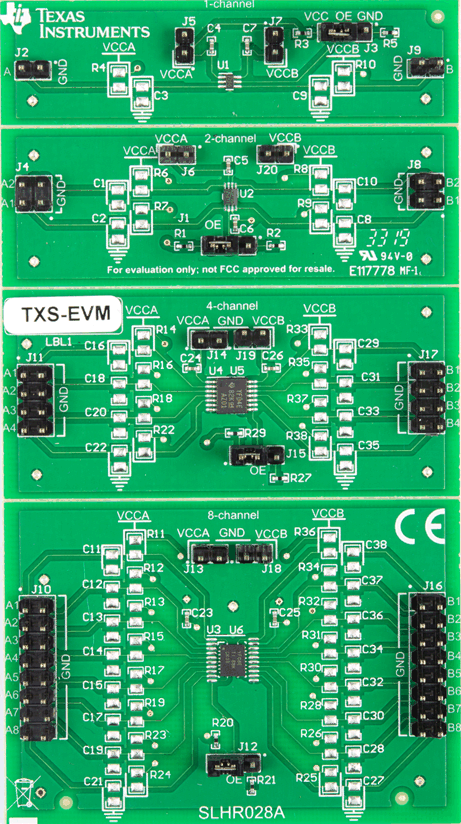SCEU020B October 2019 – June 2021 TXS0101 , TXS0102 , TXS0104E , TXS0108E
1.1.1 TXS Family
The TXS family uses two separate configurable power supply rails VCCA and VCCB with A ports tracking the VCCA supply and B ports tracking the VCCB supply. These devices are fully specified for partial-power-down applications using IOFF. The IOFF circuitry (SCEA026) disables the outputs, preventing damaging current backflow through the device when it is powered down. The VCC isolation feature ensures that if either VCC supply is powered down (0V), then the I/O ports are in a high-impedance state.
The TXS family share the same architecture and one-shot circuitry for faster logic level transitions. In addition to the One-Shot circuitry, the TXS has a “weak-buffer” I/O structure which enables both slow speed open drain compatibility and higher speed push-pull operation up to 100 Mbps. TXS0101, TXS0102, and TXS0104E devices have a fixed internal 10 kΩ pull-up resistor on the I/O ports. The TXS0108E has smart pull-up resistors that switch between 4 kΩ when the output is driving a high and 40 kΩ when the output is driving a low. Refer to the application note A guide to voltage translation with the TXS family for more information on TXS family characteristics. Careful consideration should be taken when using external pull-up or pull-down resistors with TXS devices. Refer to the application note Effects of external pullup and pulldown resistors for further information.
Table 1-1 shows the comparison between the TXB, TXS and LSF Auto-Bidirectional families of TI.
| Metrics | TXB | TXS | LSF |
| Translation mechanism | Weak buffered translation | Passive translation with NMOS and internal pull-up resistors | Passive translation with NMOS and external pull-up resistors |
| Drive strength | Very low drive of 20ua due to 4K limiting buffer | No DC drive | No DC drive |
| Applications/ Interface | Push-pull applications | Open-drain applications | Push-pull and open-drain applications |
| Speed | Up to 140Mbps | Up to 24Mbps | High speed up to 200Mbps |
| Translation flexibility | Buffered and fixed translation on A and B ports | Integrated pull-up resistors-reduces BOM cost of the system; Fixed translation on A and B ports | Flexible translation due to external pull-up resistors |
| Frequency vs load balance trade-off | |||
| I/O ports | A ports referenced to Vcca and B ports referenced to Vccb | A ports referenced to Vcca and B ports referenced to Vccb | A ports not referenced to Vcca, B ports not referenced to Vccb; allows multi-voltage translation |
| Edge- acceleration | Integrated one-shot edge acceleration circuitry | Integrated one-shot edge acceleration circuitry | No integrated one-shot acceleration circuitry |
| Vih/Vil requirements | Datasheet spec has Vih/Vil specifications | Has Vih /Vil spec but no RON for the FET | No Vih / Vil conditions, has RON specifications |
| Additional care-about | VCCA<=VCCB | VCCA<=VCCB | VCCB>VCCA+0.8 V |
Table 1-2 shows the packages supported by the TXS-EVM.
| Device | Package | Pins | Device Populated |
| TXS0101 | DCK | 6 | Yes |
| TXS0102 (TXS0102-Q1)(1) | DCU | 8 | Yes |
| TXS0104E (TXS0104E-Q1)(1) | PW | 14 | Yes |
| TXS0108E (TXS0108E-Q1)(1) | PW | 20 | No |
| RGY | 20 | Yes |
 Figure 1-1 TXS-EVM
Figure 1-1 TXS-EVM